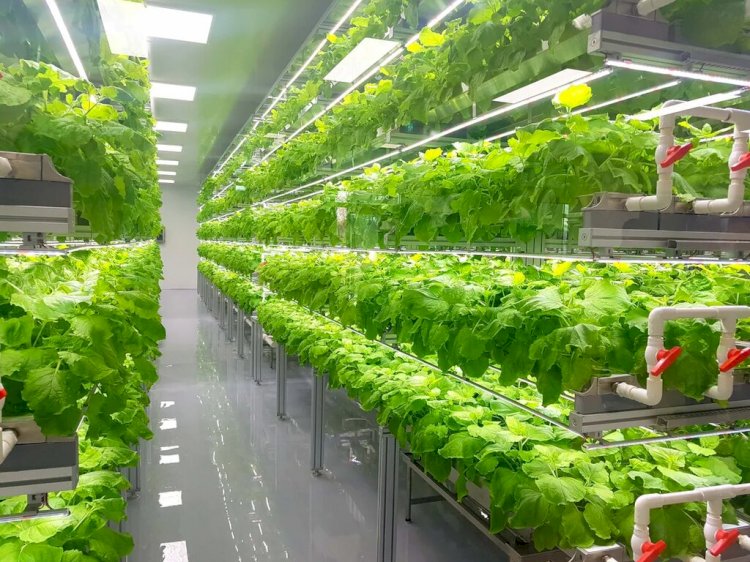Global Vertical Farming Market to Grow at a CAGR of 19.5% during 2022-2028
A recent study conducted by the strategic consulting and market research firm, BlueWeave Consulting, revealed that the Global Vertical Farming Market was worth USD 3.72 billion in the year 2022. It is estimated to grow at a CAGR of 19.5%, earning revenue of around USD 13.2 billion by the end of 2028.

A recent study conducted by the strategic consulting and market research firm, BlueWeave Consulting, revealed that the Global Vertical Farming Market was worth USD 3.72 billion in the year 2022. It is estimated to grow at a CAGR of 19.5%, earning revenue of around USD 13.2 billion by the end of 2028. The significant growth of the Global Vertical Farming Market is attributed to urbanization, rapid technological innovation, and the benefit of year-round crop production by vertical farming. Also, vertical farming assures quite stable crop yields. This is easy to make long-term contracts with suppliers since there will be a stable supply of crops and income. All these factors increase vertical farming across the globe. Furthermore, Global Vertical Farming Market is one of the most booming markets that grow continuously owing to the fast advantages and integration of new technologies like the Internet of Things (IoT), Hydroponics, Aeroponics, and Aquaponics. This new technology helps to improve plant growth and allows farms to be more profitable, efficient, and safe. In addition, vertical farming is a revolutionary and more sustainable method of agriculture as it reduces the use of water, and soil, as well as saves considerable space. Thus, Vertical Farming is the best way of growing crops without impacting the environment. However, some factors like maintenance of temperature, humidity, and air circulation in a vertical farm are the major restraining factor for the growth of the market. Moreover, vertical farming can be done indoors as well as outdoor including in buildings, shipping containers, and tunnels. This does not affect the crops by climate change, floods, and droughts like in conventional farming. Resulting in driving the growth of the Global Vertical Farming Market. Since crops grown in vertical farming are fully organic. So, it may also benefit vertical farming operators to sell their crops for higher prices. As our world population is growing quite fast, it is very important to use our land efficiently for a sustainable future. Therefore, the Global Vertical Farming Market is anticipated to proliferate during the forecast period (2023-2028) around the globe.
Based on the structure, the Global Vertical Farming Market is fragmented into Building-Based Vertical Farms and Shipping Container-Based Vertical Farms. The Building-Based-Vertical Farms segment dominates the market owing to the rising shifting of abandoned buildings in cities. In Chicago, ‘The Plant’ vertical farm was constructed in an old pork-packing plant. Moreover, Shipping Container-Based Vertical Farms are also growing in some countries. It includes the use of 40 feet shipping containers, installed with LED lights, and drip irrigation. This shipping-container farming system allows users to monitor the plant growth remotely from a smartphone or computer. All these factors boost the growth of the Global Vertical Farming Market during the forecast period (2023-2028) around the globe.
Request for Sample Report @ https://www.blueweaveconsulting.com/report/vertical-farming-market/report-sample
Geographically, the Global Vertical Farming Market is segmented into North America, Europe, Asia-Pacific (APAC), Latin America (LATAM), Middle East & Africa (MEA). The Asia-Pacific segment accounts to hold the largest share in the market owing to the rising investments and expanding operations in vertical farming by various companies in this region. Many countries in APAC are densely populated with limited availability of land farming. Since the demand for food is increasing and conventional farming is not sufficient to serve this demand. Thus, growing food locally in limited space is rising thereby resulting in the expansion of farms by companies in this region. Moreover, The sudden outbreak of coronavirus disease (COVID-19), initially declines the growth of the Food and Agriculture sector. However, post the COVID-19 pandemic, there is an increase in the awareness of health and food safety. Interest in indoor farming and vertical gardens rise during the pandemic. People started growing small crops on their balconies and terrace. which in turn accelerated the growth of the Global Vertical Farming Market. This trend in the market is likely to continue during the forecast period (2023-2028).
The leading market players in the Global Vertical Farming market are Signify Holding, OSRAM GmbH, Freight Farms Inc., Aerofarms, Sky Greens, Plenty, Valoya, Everlight Electronics Co. Ltd., Heliospectra AB, Green Sense Farms, Agrilution, BrightFarms, Illumitex Inc., American Hydroponics, Koninklijke Philips N.V., Urban Crop Solutions, and Other Prominent Players. The Global Vertical Farming Market is highly fragmented with the presence of multinational Food and beverages and pharmaceutical companies. These companies constantly launch a wide range of products to innovations to attract consumers and significantly invest in research and development activities to further innovate their offerings. Furthermore, the adoption of competitive strategies such as partnerships, mergers, acquisitions, collaborations, etc., is also prominent in this market.
Contact Us:
BlueWeave Research Blog
Phone No: +1 866 658 6826
Email: info@blueweaveconsulting.com




























